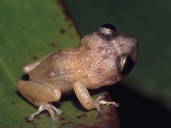|
Description
Eleutherodactylus melacara is a small frog, with adult SVL reaching 36 mm in females and 29 mm in males. The body is flattened and the head is distinctly wider than the body, with a short snout. The canthus rostralis is slightly concave in dorsal view, and a canthal bar is only rarely present. The skin of the dorsum is weakly tuberculate, while the venter is moderately areolate. There is no webbing between the toes. The digital discs are large and conspicuous. The vomerine teeth are oval and posterior to the choanae (Hedges et al. 1992). This species is greenish-brown dorsally without a distinct pattern (unicolor). The head is dark brown; the iris is dark brown below, bronze above. There is a faint brown supratympanic bar. The concealed surfaces of the thighs are dark brown. The venter is pale with some light brown flecks on the chin. This species exhibits an interesting color change (metachrosis) in life. When taken from bromeliads (where it lives), it has a distinctive dark brown snout that grades into a paler (tan) posterior body coloration. Within about 30 minutes, the dark anterior coloration disappears and the entire animal became uniform tan or light brown. (Hedges et al. 1992) . Distribution and Habitat
Country distribution from AmphibiaWeb's database: Cuba
This species is endemic to Cuba. It is known only from the Sierra del Turquino (Sierra Maestra mountains) in eastern Cuba. It occurs in rainforests and cloud forests above 850 m. This frog is one of the Cuban representatives of the bromeliad ecomorph (species that live nearly exclusively in bromeliads) (Hedges et al. 1992; Diaz et al. 2005). Life History, Abundance, Activity, and Special Behaviors
During the day it can be found taking refuge in arboreal bromeliads 1-4 m above the ground. By night, specimens can be observed in exposed positions on bromeliad leaves or rarely on leaves of trees, above 2 m. Males vocalize from bromeliads, about 1 m above the ground, although sometimes they use sites below 1 m. Calls are a series of 14-22 hollow “tocks” with dominant frequency between 2.2-2.3 kHz. This frog is a direct developing species. Clutches are deposited within the bases of bromeliad plants. The clutch size is small (probably as few as 5 eggs, with 11 eggs/clutch observed). The eggs are very large, 6.9-9.3 mm in diameter (Hedges et al. 1992; Fong unpublished). Trends and Threats
Habitat modification is considered the principal threat to this species (Vales et al. 1998). This species is threatened by habitat destruction as a result of deforestation due to agriculture, woodcutting, disturbance from tourists, and infrastructure development for human settlement (Hedges and Diaz 2004). Possible reasons for amphibian decline General habitat alteration and loss
Habitat modification from deforestation, or logging related activities
Intensified agriculture or grazing
Comments
Eleutherodactylus melacara is a member of the subgenus Eleutherodactylus. Related species include Eleutherodactylus leberi, E. varians, E. guantanamera and E. ionthus (Heinicke et al. 2007). The chromosome number is 24 (Hedges et al. 1992). Etymology- From the Greek; mela= dark, and cara = head; a noun in apposition referring to the differential head/body coloration of this species (Hedges et al. 1992).
References
Drewes, R. C., and Wilkinson, J. A. (2004). ''The California Academy of Sciences Gulf of Guinea Expedition (2001) I. The taxonomic status of the genus Nesionixalus Perret, 1976 (Anura: Hyperoliidae): treefrogs of São Tomé and Príncipe, with comments on the genus Hyperolius.'' Proceedings of the California Academy of Sciences, 55, 395-407.
Díaz, L. M., Fong, A., Viña, N., and Knell, G. (2005). ''Amphibians and reptiles.'' Cuba: Parque Nacional La Bayamesa. Rapid Biological Inventories Report 13. D. Maceira, A. Fong, W. S. Alverson, and T. Wachter, eds., The Field Museum, Chicago.
Hedges, S. B. and Díaz, L. M. (2004). Eleutherodactylus melacara. In: IUCN 2007. 2007 IUCN Red List of Threatened Species. http://www.iucnredlist.org/. Downloaded on 11 November 2007.
Hedges, S.B., Estrada, A.R., and Thomas, R. (1992). ''Three new species of Eleutherodactylus from eastern Cuba, with notes on vocalizations of other species (Anura: Leptodactylidae).'' Herpetological Monographs, 6, 68-83.
Heinicke, M. P., Duellman, W. E., Hedges, S. B. (2007). ''Major Caribbean and Central American frog faunas originated by ancient oceanic dispersal.'' Proceedings of the National Academy of Sciences of the United States of America, 104(24), 10092-10097.
Vales, M., Álvarez, A., Montes, L., and Ávila, A. (1998). Estudio Nacional sobre la Diversidad Biológica en la República de Cuba. CESYTA, Madrid.
Originally submitted by: Ansel Fong G. (first posted 2007-11-07)
Edited by: Kellie Whittaker (2007-11-12)Species Account Citation: AmphibiaWeb 2007 Eleutherodactylus melacara: Dark-faced Bromeliad Frog <https://amphibiaweb.org/species/3052> University of California, Berkeley, CA, USA. Accessed Jun 7, 2025.
Feedback or comments about this page.
Citation: AmphibiaWeb. 2025. <https://amphibiaweb.org> University of California, Berkeley, CA, USA. Accessed 7 Jun 2025.
AmphibiaWeb's policy on data use.
|






 Map of Life
Map of Life